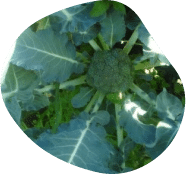VerdiLife Field Testimonials
Wood Vinegar Uses
Choose A Farmer
Clavier Mendoza
Crops: Broccoli, Cauliflower and Carrots
Clavier Mendoza has been farming for 30 years. He started using wood vinegar in a trial after observing deteriorated soil which resulted in many problems with the crops’ health. He continues this trials for 5 months and saw that wood vinegar significantly helped reduce the incidence of pests. The initial application consisted of 5 to 8 tablespoons wood vinegar, 3 tablespoons of insecticide (Fenvalerate), all mixed into 16 liters of water. This was applied during the cauliflower seedling stage. He later increased the dosage of wood vinegar to 10 tablespoons when the crops reached the vegetative stage.
Results from 5-month trial:
- Cauliflower became thicker
- The vegetables became softer and tenderer
- The use of pesticides was reduced since the normal dosage of pesticide was lowered to 50 percent
- It minimized the strong odor of the pesticides used

Broccoli NOT treated with Wood Vinegar

Broccoli treated with Wood Vinegar
Leonard Valdez
Crops: Chrysanthemum, and Celery
Leonard Valdez has been a farmer for 15 years and has been using wood vinegar for the past year. He only uses wood vinegar during the vegetative stage. During this stage, he mixed 2 tablespoons of wood vinegar with 3 tablespoons of pesticides. However, he said that the dosage of wood vinegar may vary depending on the strength of the pesticide being used.
Valdez gave the following feedback:
- The celery sprayed with wood vinegar became resistant to diseases, fungi, and insects such as leaf miner
- The leaves became thicker, shiny, robust and green
- The petioles became hard
- Celery grew in uniform height
- The smell of pesticides was lessened while insects were still repelled
- Good feed back from the buyers who said the use of wood vinegar prolonged the shelf life of their crops
Stember Ngayaan
Product: Compost (enriched soil)
Stember Ngayaan uses wood vinegar to facilitate composting. On beans, he uses a dosage of 2 cups (650ml) wood vinegar per 16 liters of water.
While using this regimen, he noticed the following changes:
- The leaves became robust
- The larvae of the pests were eliminated using only wood vinegar
- The quantity of chili increased
- Wood vinegar spray can also control bean rust, and as foliar, it makes the leaves thicker
Satur Bulay
Crop: Potato
Satur Bulay has been farming for almost 7 years. After some positive results sparked his interest in wood vinegar, he started to use it on his potato farm. He uses a mixture of 180 ml of wood vinegar and 2 tablespoons of insecticide (Fenvalerate), which is diluted in 16 liters of water. This solution is then sprayed on the potatoes once every 7 days.
He observed:
- The potato tubers were of very good sizes
- The weight of the harvest increased
- The common disease of potato plants, blight, was minimized
- The height of the growing potatoes was almost uniform
- The leaves became thicker and greener
Sotero Capsuyan
Crops: Cabbage, carrots, potatoes and lettuce
Sotero Capsuyan has been farming for 35 years. He heard about wood vinegar at a seminar in 2010. He believes wood vinegar is a big labor reducer for his family. He applied wood vinegar on cabbage, carrots, potatoes, and lettuce, spraying once a week at five-to-seven day intervals.
He noted the following results:
- Harvested carrots were uniform in size, thicker, and larger
- Celery stems became more sturdy and had no hollow petiole
- Lettuce leaves were wider and thicker
Sotero continues to use wood vinegar. He firmly believes that wood vinegar will bring fertility to the soil. He will also be creating his own compost using wood vinegar.
Rudy Atas
Crop: Bell Pepper
Farmer Atas used wood vinegar on bell peppers. He started spraying wood vinegar during the crops’ seedling stage, and continued the applications until the beginning of their fruiting stage. He combined 90 ml of wood vinegar, 1 tablespoon of fungicide, and 1 tablespoon of insecticide. This mixture was diluted with 16 liters of water. He sprayed the solution on his bell peppers at a 14-day interval.
After spraying, he had observed the following results on his bell peppers:
- Leaves became greener and thicker
- 50% increase from previous cropping
- Yellowing of leaves was minimized
Shirley Palaway
Product: Anthurium
Palaway started planting anthurium last 2007. She also plants sayote, coffee, citrus, banana, cucumber, garden peas, tomatoes and beans. Palaway and her husband became interested in wood vinegar and brought home a sample and applied it to their backyard garden. The ratio she used was 750 ml wood vinegar to 16 liters of water, which was used on a weekly interval.
After the application of wood vinegar, these are the results:
- Increased growth of the anthurium plant
- Glossier appearance on leaves: more vigorous and green
- Enhanced the shoot from the roots
- Quicker plant dry-off
- Decomposition time increased